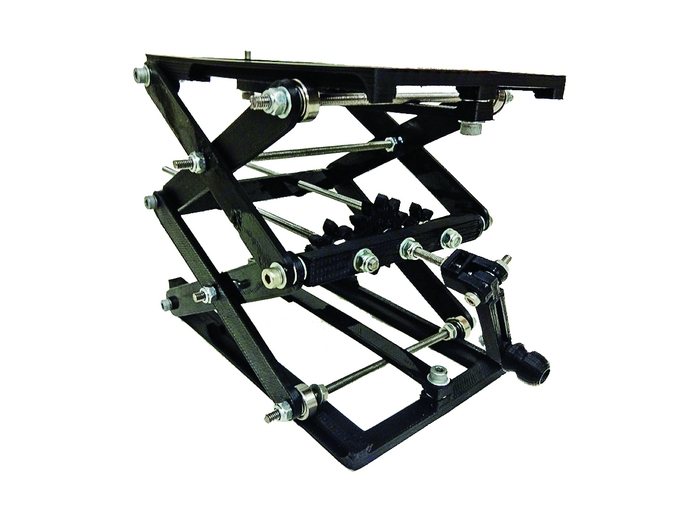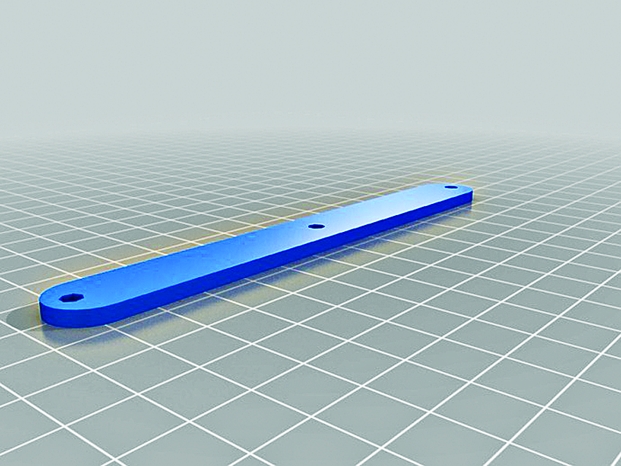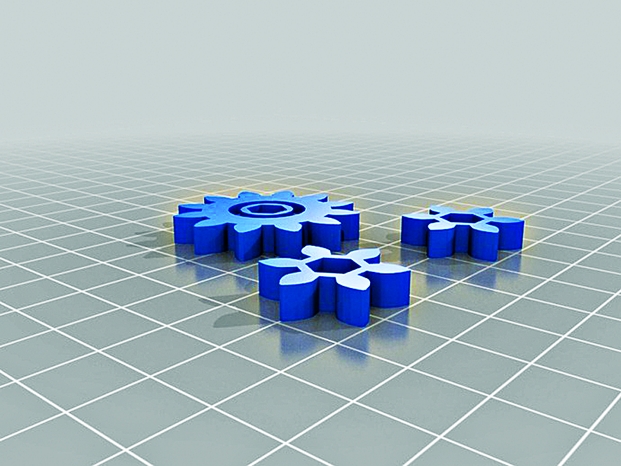Advertisement
Grab your lab coat. Let's get started
Welcome!
Welcome!
Create an account below to get 6 C&EN articles per month, receive newsletters and more - all free.
It seems this is your first time logging in online. Please enter the following information to continue.
As an ACS member you automatically get access to this site. All we need is few more details to create your reading experience.
Not you? Sign in with a different account.
Not you? Sign in with a different account.
ERROR 1
ERROR 1
ERROR 2
ERROR 2
ERROR 2
ERROR 2
ERROR 2
Password and Confirm password must match.
If you have an ACS member number, please enter it here so we can link this account to your membership. (optional)
ERROR 2
ACS values your privacy. By submitting your information, you are gaining access to C&EN and subscribing to our weekly newsletter. We use the information you provide to make your reading experience better, and we will never sell your data to third party members.
3-D Printing
3-D Printers Move Into Research Labs
Scientists are using the machines to make inexpensive and custom equipment and are sharing their designs to accelerate progress
by Lauren K. Wolf
February 18, 2013
| A version of this story appeared in
Volume 91, Issue 7

Magazines and blog posts these days are full of news about the latest and greatest gadgets made by three-dimensional printers.
Stories abound of fashion designers using the machines to print plastic clothing and hobbyists manipulating them to build objects such as guitars and record albums. In August, news broke of a Japanese firm, Fasotec, that will print a 3-D acrylic model of a woman’s unborn child from medical images for $500 to $1,100.
Even university researchers haven’t been immune to the allure of 3-D printers: The robotic devices, which build solid objects layer by layer from plastics and other materials, are beginning to appear in academic labs with increasing frequency. But rather than making trendy gizmos, scientists have been using the machines to manufacture their own laboratory equipment.
Some early adopters are already printing inexpensive versions of labware such as Büchner funnels and centrifuges. Others are adapting the machines to build specialized reaction vessels for chemical synthesis.

Academic users say 3-D printers—some of which sell for as little as $1,000 to $2,000—are saving their labs thousands of dollars, money that is especially welcome now that federal funding is so difficult to obtain. For instance, the National Institutes of Health funded only 18% of the applications for research project grants (R01s) last year, down from 30% a decade ago.
Fans of lab-based 3-D printers also believe that sharing their equipment blueprints via open-access databases will help advance scientific progress. They say it’ll make cutting-edge devices available to researchers in the developing world who otherwise wouldn’t have access to them.
“I see a future where you could have a state-of-the-art lab that’s been completely printed,” says Joshua M. Pearce, a materials scientist at Michigan Technological University.
Pearce first introduced a 3-D printer into his lab in 2009, when his students wanted to make a prototype of a solar-powered laptop charger they had developed. He had discovered that getting a plastic model of the charger manufactured by a prototyping company would cost the lab hundreds of dollars. So he purchased a RepRap—a type of low-cost 3-D printer—to do it himself.
RepRaps make 3-D objects by heating plastic filament and extruding it through a nozzle onto a so-called build platform. After one layer is printed, the platform lowers a fraction of a millimeter, and the machine prints the next layer.
Once the printer arrived in the Pearce lab, 3-D printing fever broke out as the researchers realized the device could be harnessed to make much more than nonfunctional plastic models.
“Something happens when you actually have rapid prototyping capabilities in your hands,” Pearce admits. The feeling that comes with being able to make objects from scratch, he says, “is like a disease—but a good one.”
After looking around the lab, the researchers decided that, using their 3-D printer, they could make a lot of the items they saw just as well as equipment suppliers could and for a fraction of the price that suppliers charge. Pearce and his group have now made a multitude of pieces for the lab: optical fiber mounts, lens holders, and a lab jack, to name a few.
The lab jack, in particular, is a poster child for taking up 3-D printing in the lab, Pearce says. The materials scientist needed the gear-based device—which is similar to a jack used for changing a flat tire—to raise and lower mounted optical equipment by precise amounts. But he got a quote from a supply company for one that was about $1,000.
“I thought, ‘You’ve got to be kidding me,’ ” Pearce says. “All this does is move something up and down. Certainly, we could make that.” So the researchers used computer-aided design (CAD) software to draw digital blueprints for a lab jack of their own and then printed its parts from plastic filament, all for under $1.00. Afterward, they shared their CAD code for printing the jack on thingiverse.com, an open-access online database for digital designs.
The lab jack blueprints have now been downloaded about 1,400 times.
Manufacturers often mark up the prices of laboratory devices by shocking amounts, says Russell Y. Neches, a fourth-year microbiology graduate student at the University of California, Davis. “If you take the equipment apart and add up its bill of materials, you’ll sometimes see a factor of 1,000 difference between the material costs and the retail price,” he says.
Neches took aim at this sticker shock in November 2012 when he wrote a post on his personal blog entitled, “Why doesn’t your lab have a 3D printer yet?” In it, he describes making his own electrophoresis gel combs with his lab’s 3-D printer.
A gel comb is a pronged piece of plastic that scientists use to put wells into agarose electrophoresis gels. It forms part of a mold into which hot agarose is poured, and it’s removed after the gel solidifies. Researchers can then inject DNA or proteins they’re studying into the divots left behind by the plastic piece.
RATCHETING DOWN COST

The black portions of this lab jack—“thing” 28,298 on online database Thingiverse were produced by a 3-D printer from CAD designs (blue insets) and then assembled with assorted metal parts.


Credit: Courtesy of Joshua Pearce (all)
Given gel combs’ rudimentary function, Neches was more than a little mystified when he looked in a supply catalog and noticed they each came with a $50 price tag. “While I appreciate that companies need to make money, this is a ridiculous price for a lousy little scrap of plastic,” Neches wrote on his blog.
Rather than order them from the supplier, he sat down, measured the dimensions of the commercial combs, and wrote a few lines of computer code that would tell his lab’s 3-D printer to make equivalent parts. All told, Neches printed six combs at 21 cents apiece—a cost savings, he figured, that accounted for just under 20% of the printer’s purchase price ($1,500).
According to Michigan Tech’s Pearce, “The printer can easily pay for itself in any kind of reasonable research lab.” In 2009, when he bought his RepRap, only a few designs were available on Thingiverse. Now, he adds, there are almost 50,000 “things” to download and build, hundreds of which are scientific tools.
Some scientists, however, say that the emphasis on 3-D printing’s ability to save research funds shouldn’t be overhyped.
“In my group, we have quite a few postdocs who are learning CAD so they can do 3-D printing,” says Leroy Cronin, a chemist at the University of Glasgow, in Scotland. Not all scientists are comfortable with CAD design and computer code, he says. So if he had to assign a cost to his postdocs’ training time, Cronin contends, 3-D printing probably wouldn’t save as much money as everyone makes out. “Our time is actually quite valuable.”
On the other hand, some scientists don’t have a surplus of funds, so they are willing to invest with workhours, Cronin says. And picking up a design from Thingiverse that someone else has already sweated over could save both time and money.
This is especially true for the developing world, Neches says. “There are plenty of countries that produce good science that are not rich countries,” he says. High markups on equipment prices by suppliers shut researchers from those places out of cutting-edge science, Neches contends, but low-cost 3-D printers could let them back in.
Pearce admits that there’s a steep learning curve associated with CAD, making 3-D printing technology not quite right for everyone just yet. But he points out that design programs are becoming increasingly user friendly. For example, the 3-D printing community has already “built” an open-source CAD programming language called OpenSCAD that uses simpler code commands than regular software. “If you understand math and geometry, you can use it,” Pearce says.
Even better, the 3-D printer firm that hosts Thingiverse, MakerBot, released a computer app two weeks ago that practically wipes out the need to understand computer code at all. The app enables users to download an existing design and drag scale bars across the computer screen that adjust an object’s desired dimensions. Once the user has finished optimizing a design, the app spits out the OpenSCAD code needed to print the part.
“Give it about a year to catch on,” Pearce contends. “It will allow people who know nothing about code at all” to print beaker racks and pipette holders in any flavor.
In the meantime, Cronin says he’d rather have his students using 3-D printers for cutting-edge science instead of designing tools to save money. For the Glasgow chemist, that means having his team design custom reaction vessels for making chemicals.
In April, Cronin’s group demonstrated that they could synthesize organic compounds and inorganic nanoclusters within the walls of so-called reactionware printed from silicone (Nat. Chem., DOI: 10.1038/nchem.1313). The researchers also made the reaction vessels part of the reaction by adding palladium carbon paste to their walls during printing. They then used the catalyst-lined chambers to hydrogenate a chemical loaded inside.
Cronin hopes that one day his group will hit upon a reaction whose outcome is made possible only by carrying it out inside an intricately designed 3-D printed chamber. And although he’s triggered skepticism from some chemists, he hopes to one day synthesize compounds such as ibuprofen in the vessels as a proof of principle that drugs can be made in reactionware.
A lot of pieces need to fall in place for Cronin’s vision to become a reality. But he’s excited at the prospect of sharing his 3-D printed reactionware with the chemistry community. By including the CAD file needed to print the reaction vessels in the supplementary information section of a scholarly article, he says, “others will be able to load it, print it, and verify what we’ve done.”
Advocates of 3-D printing say it’s only a matter of time before researchers jump on the bandwagon and bring the technique into their labs.
In the early days of 3-D printing, Cronin says, “people thought it was cool but gimmicky.” Now, he says, researchers are starting to use it to solve problems. “It’s going to catch on as long as the printers keep coming down in cost,” he adds. “I can’t imagine what’s going to be done with it next, but I’m really excited.”


Join the conversation
Contact the reporter
Submit a Letter to the Editor for publication
Engage with us on Twitter